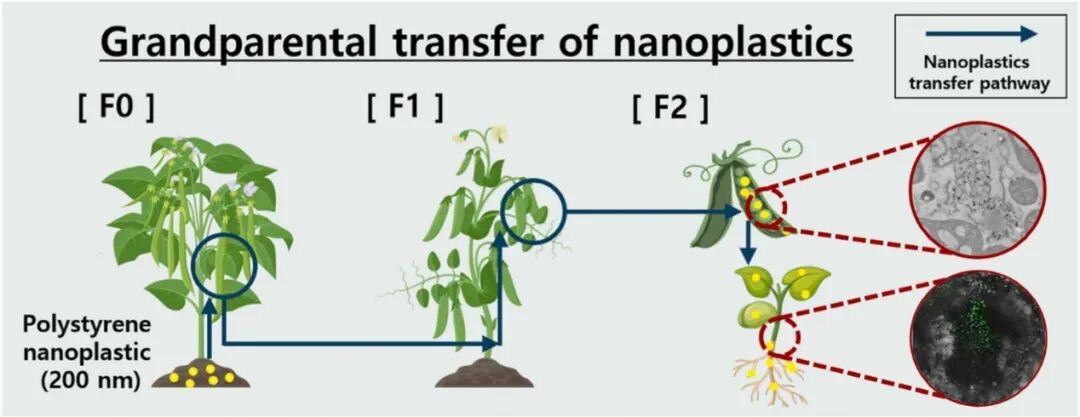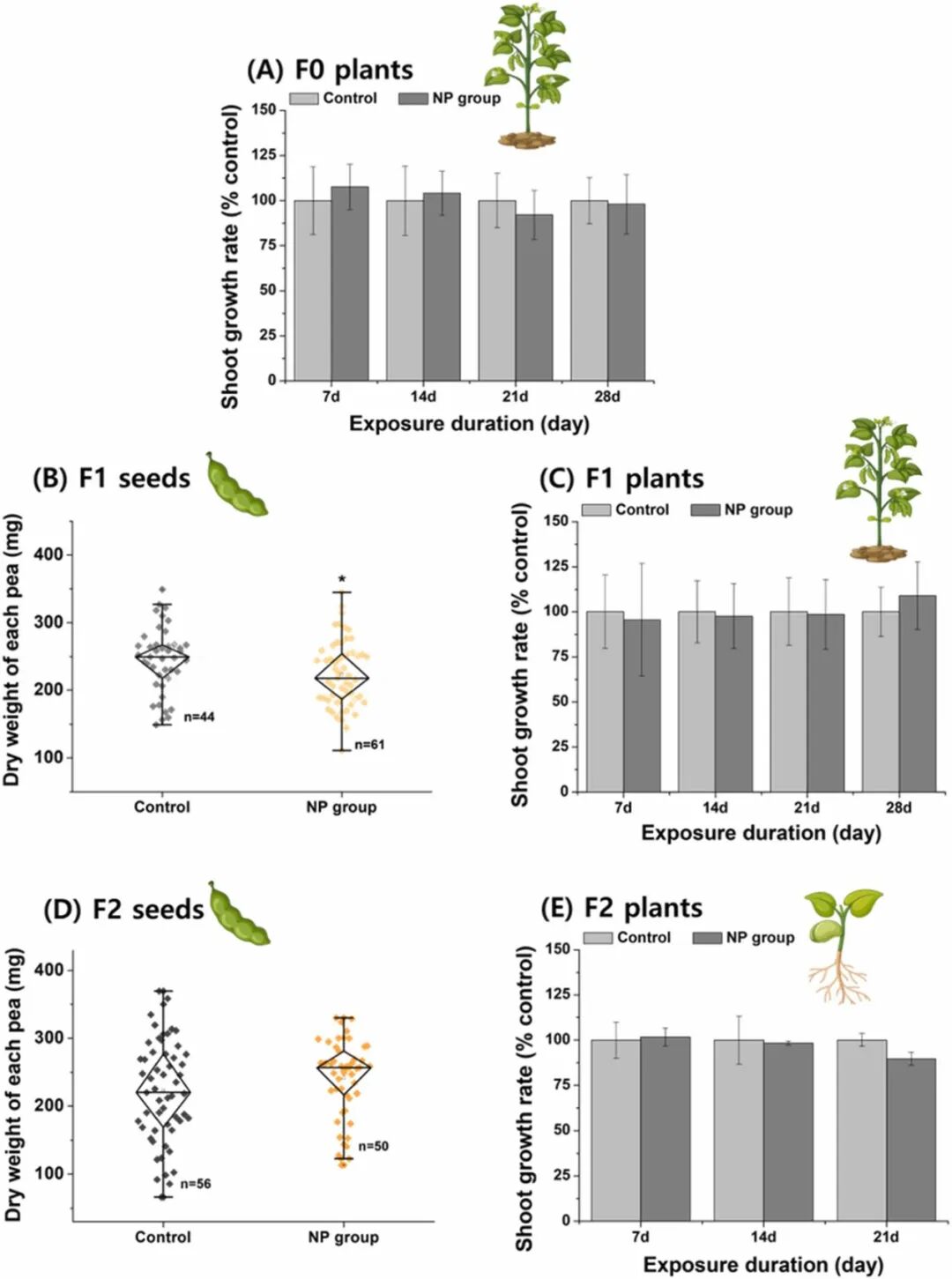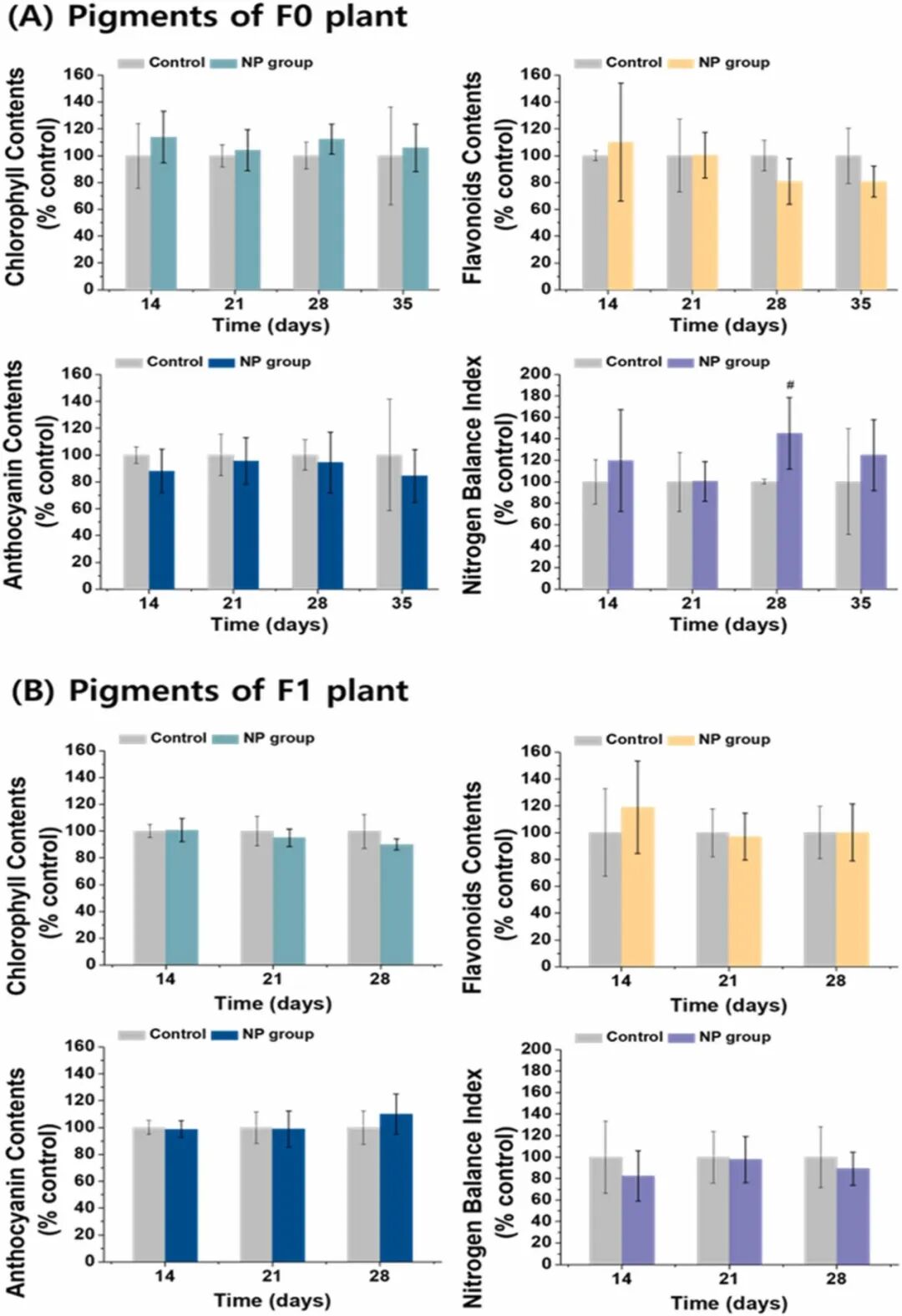
On April 8, 2025, the team led by An Yunzhu from Korea’s Kookmin University published a research paper titled “Grandparental transfer of nanoplastics in pea plants (Pisum sativum): Transmission from soil to third generations” in the Journal of Hazardous Materials (IF 12.2). This study indicates that nanoplastics can reach humans through the food chain and calls for improved food safety measures regarding microplastics and nanoplastics.
Research Approach: With the increasing abundance of microplastics and nanoplastics in soil environments, there is growing concern about the transfer of nanoplastics to soil biota. Therefore, this study aims to determine the multigenerational transfer of nanoplastics (200 nm, polystyrene) in plants through long-term exposure. Only the first generation (F0) of pea plants was exposed to nanoplastics, while subsequent generations (F1 and F2) were replanted in clean soil without nanoplastics. Confocal laser scanning microscopy and transmission electron microscopy were used to examine the F2 generation’s pea fruits and plants. Green fluorescence of nanoplastics was observed compared to the control. Nanoplastics were located within cells and intercellular spaces, and enclosed within the endoplasmic reticulum and vacuoles. The fluorescence of nanoplastics detected in F2 plants confirms that nanoplastics can not only transfer to offspring but also to the third generation. Our results indicate that exposure to nanoplastics in the first generation can continuously transfer to subsequent generations, further emphasizing their potential for persistent cycling in soil ecosystems. It also suggests that nanoplastics can reach humans through the food chain and calls for improved food safety measures regarding microplastics and nanoplastics.
Exposure Experiment of Pea Plants to Nanoplastics
Pea (Pisum sativum) seeds were purchased from a commercial store (Danong, Namyangju, South Korea) and stored in a refrigerator before the experiment. These seeds were non-GMO. Twenty-four hours before exposure, the seeds were disinfected with 5% sodium hypochlorite, rinsed with distilled water, and incubated in the dark at 25°C. Two germinated seeds (F0 generation seeds) were selected for each exposure group, using different colored pots for each group, with 10 replicates per pot. To minimize nanoplastic contamination from experimental tools, sterile bags were used. The growth medium (a mixture of coconut coir, vermiculite, and perlite) was purchased from the commercial market, air-dried, and sieved through a 2 mm mesh. Dried soil (300 grams) was placed in each pot, and distilled water was added to achieve 67% soil moisture. For the nanoplastic exposure group (NP group), the stock solution was diluted with distilled water to achieve a test concentration of 20 mg/kg. Nanoplastics were added only once during the initial exposure. The experiment was conducted in a growth chamber, maintaining a temperature of 25°C, a light cycle of 16 hours light/8 hours dark, and 80% humidity. Distilled water was replenished every two days to maintain moisture, and stem growth was measured every seven days. Exposure continued until pod harvest. When the pods were fully harvested, the number of pea fruits (F1 generation seeds) was recorded, and their dry weight was measured. After harvesting, they were stored at -80°C for the next exposure experiment. To avoid cross-contamination, each group of samples was placed on different levels of the incubator, and all operations, including moisture replenishment, measurement, and harvesting, were conducted separately for each group. After each experiment, the incubator was cleaned with alcohol and a cloth soaked in distilled water.

Figure 1. (A, C, and E) Growth rates of pea plants (Pisum sativum), and (B and D) dry weights of harvested peas from each generation. (E) The growth rate experiment set up 20 replicates, but the F2 generation plants were set up with only 5 replicates.
Growth and Yield of Peas (P. sativum) Exposed to Nanoplastics
No significant differences in plant growth rates were observed, indicating that the transfer of nanoplastics to the first and second generations did not inhibit growth (Figure 1). The number of F1 generation seeds harvested from 20 F0 plants was 44 for the control group and 61 for the nanoplastic (NP) treatment group, while the number of F2 generation seeds was 56 for the control group and 50 for the NP treatment group. This is consistent with previous studies conducted under the same conditions, where the control group harvested 60 seeds and the exposure group harvested 48 seeds. The dry weight of F1 generation pea seeds was 245.10 mg for the control group and 222.69 mg for the NP treatment group; for F2 generation, the dry weights were 223.47 mg for the control group and 241.68 mg for the treatment group. Additionally, no significant adverse effects were observed on pigments, including chlorophyll, flavonoids, and anthocyanins, which are important factors for growth and yield (Figure 2). Growth and yield are the most intuitive indicators of adverse effects on plants, and many studies on microplastics have measured plant growth [20], [21], [75]. Although many studies report growth inhibition, no significant growth differences were observed in this study. The characteristics of microplastics and nanoplastics, including type, size, and concentration, can affect their impact on biota [26], [57]; however, the concentration of 20 mg/kg used in this study is relatively low. Although these changes exhibited different patterns between F1 and F2 generations, these differences did not reach statistical significance. In the F1 generation, the NP treatment group had a higher yield than the control group. Conversely, in the F2 generation, the NP treatment group showed a slight decrease in yield compared to the control group, which increased. Similarly, although not statistically significant in this study, the chlorophyll content of F0 plants exposed to nanoplastics was slightly higher than that of the control group, while it slightly decreased in the F1 offspring (Figure 2). This observation is consistent with previous studies indicating that microplastic-induced changes in the metabolism and storage of photosynthetic products may impact plant productivity [27], [42], [64]. Therefore, the observed changes in productivity and chlorophyll levels may be related.

Figure 2. Pigments measured using Dualex in F0 (A) and F1 (B) plants. Chlorophyll, flavonoids, anthocyanins, and nitrogen balance index were measured for each generation.
Written by: Lin ZhihaoReviewed by: Liu GuangyangOriginal link:https://doi.org/10.1016/j.jhazmat.2025.138198DisclaimerThis article is for research sharing only, to promote scientific communication, and is not for profit. If there is any infringement, please contact us for deletion. Some images and text materials are sourced from the internet and are for research sharing only, to promote scientific communication, and are not for profit. The content does not represent the views and positions of this public account, and this public account does not guarantee its accuracy or reliability, and is for reader reference only. If there is any infringement or unauthorized publication, please contact us, and we will promptly correct or delete it. Thank you.Contact: Liu Guangyang, Quality Inspection Center, Institute of Vegetables and Flowers, Chinese Academy of Agricultural Sciences, [email protected]